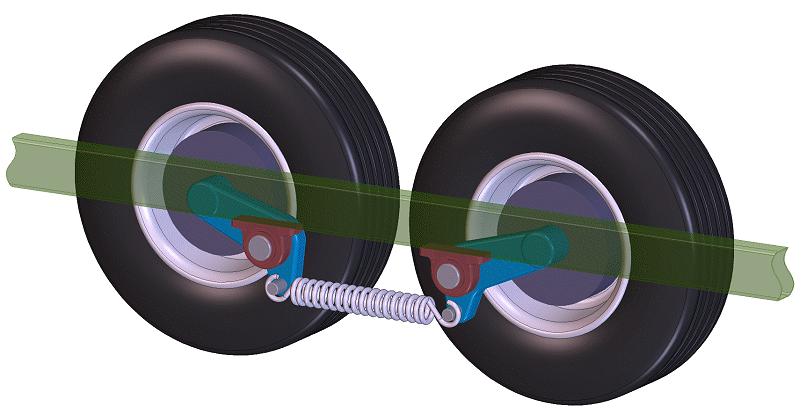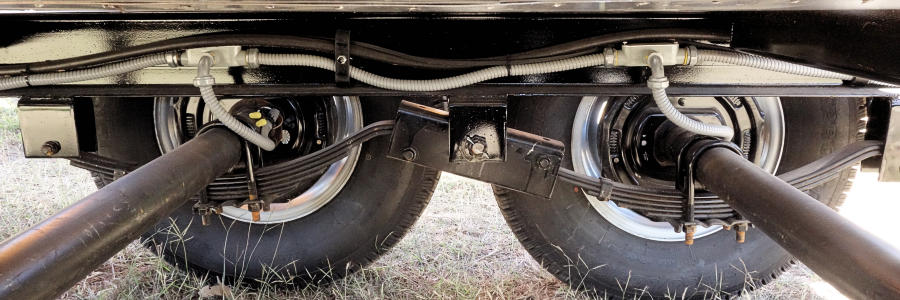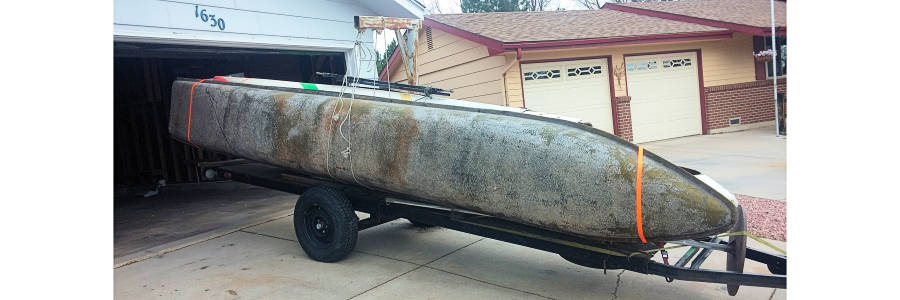It all rides on the trailer axles, so get them right. Here are some common technologies (and misnomers) for tandem axles and other multi-axle trailers.
The most common are tandem axles configurations. Triple axles are less common, but you do see them once in a while. Going up from there is far less common, so we’ll keep this discussion to Tandems and Triples.
Why use Tandem Axles? (or Triples?)
The concept is easy . . . ya gotta carry more load, so put more axles under the trailer. Easy enough, but Why not just buy a beefier single axle?
There are 4 big reasons for multiple axles, plus one more little one:
- Tires. To carry more weight you need beefier tires, and higher capacity (road rated) tires are usually bigger diameter. That affects bed height, and a host of other details.
- Tires. With a single axle, regardless of how beefy it is, if you damage one tire, you have a major issue. With 2 or 3 tires per side, you can usually stop before serious damage occurs.
- Load distribution. With more axles, the load is spread over a much broader portion of the frame. That helps with strength.
- Ride. With multiple axles, load to the ground is distributed over more points, so when a tire encounters a bump or pot hole, the load sharing linkage mitigates the contribution to bouncing or jarring the trailer. This gives a smoother ride.
- Some say it gives Better Tracking, which it can if everything is set up correctly because multiple axles give a much larger footprint. BUT, if the axles are off, just a little, it will do the opposite and make the trailer less stable.
What Technology Should I Use For Multiple Axles?
There are tons of places to purchase axles, and the hardware is pretty standard and common. So, just buy the axles and weld them on. Right? Mostly, but there’s more about axles than that. Let’s look at some of the technologies.
-
Leaf Spring Style:
These are the most common, by far, and also the cheapest — but those are not the only advantages. They are the most popular for lots of good reasons. Choose between Slipper Style and eye-eye style. (Slipper shown here, eye-eye style shown below in the image for Hybrid.) As a rule of thumb, think Slipper Technology for heavy loads — 6000# Axles and up. Think Eye-Eye type for lighter applications 4000# axles and below. Yes, there is a lot of wiggle room, and it’s just a rule of thumb, so consider the application. Oh, and be super careful with used trailer axles that might not be what they seem.

-
Torsion Axles:
I will refer to this as “Twin Axles” rather than “Tandem Axles” because the 2 do not interact with each other. They do not equalize, nor do they really equally share the load, unless the road is flat and level. This configuration is a disaster waiting to happen IMO, and here is the engineering to support it (written in simple terms).
Basically, if you go up a bump (or down), one axle will completely (or almost completely) take all the load and, depending on your capacity, maybe overload. While it’s true that torsion axles handle overload conditions better than springs, the tires don’t, and frames don’t. (See Hybrid below, and the article comparing torsion axles with leaf springs.)
For more on the technical side, this article on Independent Trailer Suspension Concerns looks at the topic generally – including videos. Read the links, because here is so much more to this topic.

-
Hybrid Using Rubber:
One of the desires for using twin torsion axles (as shown above), is the vibration damping that comes with rubber. By simply using rubber in the equalizer with leaf springs, much of that effect is achieved. See the image below. This is just one example, and there are many different hybrid types, but the rubber provides vibration damping AND the equalizing. This allows the axles to share the load when the road is not flat and level while offering vibration damping. This is a much better choice because it maintains the load share. See more options in our article about substitutions for Shock Absorbers.

-
Hybrid Using Mechanisms:
There are several ways you can use rubber for suspension yet still achieve load sharing. As an example, here is a patent drawing showing a simple method to connect a pair of torsion axles for equalization with a mechanism. And there are more methods too. Just be careful not to violate someone’s intellectual property rights by copying.

If you really want tandem axles and torsions, try one like our Twin Torsion Axles. It’s a hybrid of torsions and Center Pivot noted below. The design is for you, and it’s royalty free. -
Center Pivot (or Walking Beam):
Another approach entirely is that of a center pivot to accommodate equalization. (Also called a Walking Beam Suspension.) This is the best equalization, and I can see why they are so proud of it. Click the image to watch a YouTube video of it in action. Very cool, but this one from Timbren is very expensive — like almost 10 times as much as leaf springs. Also it does not spread the load over a broad area of the trailer frame, so attention must be given to strength with this kind of a trailer suspension much more than with leaf spring tandem axles.

The second image shows just the mechanism.
 The concept of the center pivot is not new, over the road trucks have been using them for years, but with leaf springs rather than the mechanism shown here. It is not, however, common with smaller trailers.
The concept of the center pivot is not new, over the road trucks have been using them for years, but with leaf springs rather than the mechanism shown here. It is not, however, common with smaller trailers. -
Unique or Less Common:
There are, of course, many more options — and variations of the above. One example is this Low Profile Trailer Suspension which seems to work well for tandem axles.
 We’ll suffice with this. Some others require a lot of fabrication. And all have some advantages to consider. It’s fun and interesting research if you want to know more.
We’ll suffice with this. Some others require a lot of fabrication. And all have some advantages to consider. It’s fun and interesting research if you want to know more. -
Specialty Situations:
We would be amiss to fail to mention the specialty situation of axles without suspension. While there are some unique situations where rigid mounting is useful, they are rare. We mention it, and link the article, but generally do not recommend them – especially as tandem axles.
Considerations In Choosing A Trailer Suspension
A final choice for trailer axles should balance many factors and your situation. Consider the trailer uses, the environment (wet, dry, on-road, off road), cost, etc.. Here are a couple keys to success.
With multiple axles, make sure they will share the load. There really is no point for multiple axles if they don’t work together. We call it “Load Share” or “Equalization”. Since the road is not always flat, and the trailer not always level, the axles need to accommodate uneven ground while still sharing the load.
Imagine for a minute a trailer with tandem axles, without springs or suspension. As the trailer rolls over a speed bump, the first wheel rises on the bump, then because there is no equalization, the back wheel may lift off the ground too. This is an example where axles don’t share the load. On top of the bump, the one axle (and it’s poor tire) takes all the weight.
Think again about a trailer with tandem axles, but this time, think about it with an equalizing suspension. (The little gold up-side-down Y shaped thing between the trailer springs in the image above is the “Equalizer”.) It moves like a “Teeter-Totter” to adjust the relative vertical position of the wheels as they go over bumps or into dips. See this article for an equalizer action animation.
In this engineering opinion, load sharing is absolutely essential. Whether with springs or torsion or other suspension type, they need to share the load. To illustrate, please see our post Springs Vs. Torsion Axles. There we show how Torsion Axles naturally cause higher stress, so imagine that doubled! It’s not a good idea — especially when you can accomplish almost the same damping with a hybrid system as shown above. Longer springs also help.
Trailer Axles And Stability
A second key to success is making the axles stable under the trailer. For discussion purposes let’s look at leaf springs – which include both slipper and double eye as well as rubber isolated hybrids.
Of course, we start by mounting the axle(s) straight – single, tandem axles, triples or more. If they are not true, they will “fight”, and that causes problems.
Next, is a stable connection to the frame. To illustrate, think about the classic single axle leaf spring. The forward portion of the leaf spring acts as a trailing arm from the frame. A trailing arm is a very stable way to mount an axle – and it is one reason people like the feel of torsion axles.
When tandem leaf spring axles mount in the classic way (like in the image below), the back axle is a leading arm. That is not as stable. Yet, because they connect with the linkage in the center, and because motion in one moves the other, it becomes stable. It’s a quasi stable condition that proves to work. As a side note, this is why you sometimes see trailer brakes on just the front tandem axle, and not on the back one.
Slipper style leaf springs pin the back axle springs to the equalizer give a trailing arm effect for all axles. Looking at the photo above showing slipper springs, it is easy to see that the back springs attach to the center equalizer, allowing them to “float” at the back. This is also quasi stable because movement in the equalizer actually moves the back axle just a bit. This is not bad or dangerous in any way, but it’s worth understanding, and it makes rear axle brakes work better (more stable). That’s one reason for the 6000# rule of thumb.
Walking Beam Style
The trailing arm discussion above is most applicable when the axles attach with a flexible or semi-flexible member. Leaf springs are semi flexible. Torsion rubber isolation makes the torsion axle arm drive the flexible connection, so it does best as a trailing arm.
Walking beam styles like the Timbren Silent Ride shown above are a little different. True, the back axle is like a trailing arm and the front axle fixes to the same beam. Anyway, the dynamics are a little more tricky, but this type of system is well proven in many industries.
Triple Trailer Axles
For really heavy or really long trailers, triple axle configurations are common. In context of the discussion above, making the middle axle both equalized and front anchored becomes a bit of a challenge. Slippers solve that problem for the center axle just like the mechanism shown for the tandem axles in the photo of leaf springs above. Double eye spring configurations solve the same task with another type of equalizer. Compare the equalizer rocker for the tandem axles and triple axles in this drawing below. Note the front equalizer as compared to the back one for the triple.
Trailer Stability
Please note the discussion above is about axle stability under the trailer. Overall trailer stability requires axle stability, but there is more too, including proper axle position under the trailer. And, making sure the axles are straight and parallel under the trailer. For more information, please read those linked articles, and our article on Synthx.com about trailer stability.
The interesting point with stability – it is a reflection of all the separate pieces. Tires live or die if the trailer is true and stable. Other suspension wear issues are often a function of building a trailer true and stable. The ease of towing and fuel economy suffer when things are not right with the axles. And, it becomes more important from One axle, to Tandem axles, to Triples.
Tandem Axles Recommendations
If you want an off-the-shelf option for a great ride (and have an good strong frame), the Timbren Silent Ride may make the perfect tandem axles. Or, if you want something unique, and effective, try a tandem axle setup like this twin teetering torsion design we did. (See the video too.)
If you’re like most of us, cost is important, so the next best choice is a leaf spring suspension with a rubber isolator in the equalizer as shown above. There are many kinds for tandems and for triples. Finally, the standard leaf springs on tandem axles (or triples) are a well proven, solid (and the least expensive) choice. Use eye-eye for lighter applications, and slipper style for the heavy duty ones.
Again, I would never use twin torsion axles without some accommodation for load sharing. Before dismissing this “un” recommendation, read our other post about the engineering side of Springs Vs. Torsion Axles and realize it is compounded with heavier trailers and more axles.
More On Tandem Axles?
Watch for more about trailer axles in general and tandem axles in specific — in coming posts — like this one looking at spring mounting. There is too much to discuss on just one page, or even on may. Another good source is the set of articles titled “What Makes A Good Trailer?” from Synthesis.
Do a search using the “Show Me” search bar at the top of this page for a lot more information. Good luck with your learning.













Comments